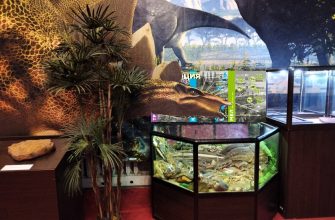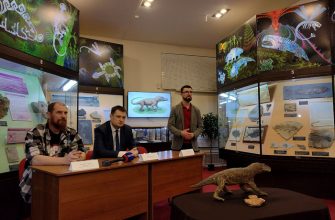A.U.Khlyupin
The world of ancient animals was huge and various. It was interested by people at all times. Long time ago people concerned unquestionable tracks of once having lived on the Earth prehistoric life. Since then they have been trying to find explanations for their incomprehensible finds: shells of long ago died out mollusks, bones of unknown animals, imprints of non-existent plants…
Long before appearance on the Earth dinosaurs there was the age of lizard prevalence. They were animals neither reptiles nor mammals. It happened on the border of 2 huge space of time, 2 eras: Paleozoic and Mesozoic.
Fossilized rests of pangolins having lived in Permian period of Paleozoic era are found by scientists on many continents. And the largest localities of bones are in South Africa, Eastern Europe, China and North America.
Known in the scientific world since 1933, the Kotelnich locality became the subject of serious scientific interest. Since 1990 and during last 10 years 15 new species of reptiles remains of Permian period were discovered on its territory. Besides big parareptiles-pareiasaurs the numerous remains of seldom occurred genus of vertebral mammal-like reptiles, were discovered near Kotelnich. These reptiles played great role in evolution of mammals which were the most alike in structure and the way of living.
The reptiles whose remains were discovered near Kotelnich, lived on the Earth 255 million years before a human being appeared. During last thousands of years the annual spring floods wash out the layer of bony remains.
Many finds are being scientifically processed now and are not identified yet. Unicom of Kotelnich finds is that there is only one analog in the world—fauna Karoo in the South Africa. Karoo fossils are of worse conditions, they are less presentable—the reasons are only geological. Kotelnich fossil deposition had been deign laid in the conditions of clay swamp, the alive animals were caught there, that’s why we deal with splendid skeletons, which were found in the occurring during their lifetime poses—backs upwards, standing on their legs. Referring the unanimous scientific opinion.
All field works on the locality and cameral processing materials are implemented by the employees of this Museum. The Museum involves the leading Russian and foreign experts to complex researches of palaeontology, geology, stratigraphy, hydrology and ecology of Kotelnich locality, and lets to make serious palaeozoogeographic conclusions.
Kotelnich fauna doesn’t matches any equivalents and Kotelnich locality is the most unique object for scientific and cultural-propagandizing purposes.
In Central Russia the first large locality of Upper Permian reptiles was found near the town of Kotlas, on the Small North Dvina river, at the beginning of the XX century by V. P. Amalitskii, professor of Warsaw University.
With its appearance North Dvina’s fauna is very similar to South Africa’s fauna of the Karoo Basin. It lets to make some seriously observations over spreading of Upper Permian faunas on different continents. In former times these continents were one whole supercontinent Pangea, which formation finished at the beginning of Mesozoic era in Triassic period.
Following discovery of Prof. Amalitskii there was systematic research of permian continental sediments in Russia. There were some discoveries of new large ancient reptiles’ rests localities.
One of the biggest in the world locality of fossil remains of vertebrates related to Permian period of Paleozoic era is situated on the territory of Kotelnich district in Kirov region—“Kotelnich locality of pareiasaurs”..
The first formal palaeontological work was conducted in 1933 when, S. G. Kashtanov, a young hydrogeologist from Kazan University, discovered fossil bone on the river bank 18km south of Kotelnich. He later became a professor at the University. That first work uncovered two complete pareiasaur skeletons.
In 1935 an expedition led by A. P. Hartmann-Weinberg, of the Palaeontology Laboratory of Moscow State University, who specialized in the study early reptiles, uncovered two incomplete skeletons and two pareiasaur skulls near the village of Volki. One skull was notably larger than the other. Hartmann-Weinberg (1937) described the animals as two species: Pareiasuchus vyatkensis and Anthodon rossicus. However, M. F. Ivachnenko in 1972 redescribed the two species as one and the same: Deltavyatia vyatkensis. The different sized skulls belonged to animals of different ages (juvenile and adult).
Between 1937 and 1949 only four pareiasaur skeletons near the village of Boroviki were discovered by student, B.P. Vushkov. One was complete. No further information on the discoveries is available.
In 1949 a crew from the Palaeontological Institute of Moscow prospected 12 km of Vyatka river section, from Vishkil to Patraki, and discovered seven very well preserved pareiasaur skeletons, together with six incomplete skeletons.
Two additional skeletons were found in 1950 by a man from village of Boroviki, but they were left in-situ to be excavated by later expeditions.
I.A. Efremov and B. P. Vushkov (1951), from the P.I.N., catalogued the Permo-Triassic tetrapods of Russia. The Kotelnich locality featured in this catalogue, and was referred to as having the largest concentration of pareiasaur skeletons in the world.
In the 1970’s S.N. Getmanov, J.M. Gubin, M.F. Ivachnenko and N. Kalandadze, workers from the P.I.N. found some skeletons of pareiasaurs – the main species of Kotelnich’s fauna and therapsid material (Dvinosaurus, Proelginia, Proburnetia vjatkensis) in green sandstone lenses.
In 1990-91 D. L. Sumin, a freelance palaeontologist, and his company of fossil hunters found several pareiasaur skeletons and a complete skeleton of a dromasaurian. The latter was to be the genotype of Suminia getmanovi, which was described by M. F. Ivachnenko (1994). S. I. Getmanov, from the P.I.N. was the finder of the genotype specimen.
By 1991 a small group from Kirov and Moscow led by Sumin discovered a new fauna at different stratigraphic levels of the Kotelnich locality, which was dominated by advanced mammal-like reptiles. Unlike the previously known pareiasaur assemblage this vertebrate fossil assemblage consisted of skulls and fragments of smaller animals such as Dicynodontia, Therocephalia, Ripeosauria and Dromasaurs.
Moscow’s interest heightened with the new discoveries. A commercial concern was established with the formation of the “Kamyennii Tsvyetok” or “Stone Flower Company” which traded in fossils, gems and minerals in order to fund further field seasons and the development of the Kotelnich locality. The company was dissolved in April 1995 after five field seasons at the Kotelnich locality.
From 1992 I enlisted the assistance of enthusiastic youngsters from schools in Kotelnich, volunteers from Kirov and Kirovo-Tchepetsk during their summer vacation. Currently, the excavation of the Kotelnich fauna is in the control of the Kotelnich Palaeontological Museum, which first opened its doors on the 24 November 1994, under the My direction. The museum in unique in Russia in that it deals exclusively with one specific faunal locality.
In research works the complex method is used, that’s why not a detail escapes scientists’ attention: neither the smallest bone, nor imprint of plant, or geological structure. Because the locality is well studied there is an opportunity to use the base of expedition and museum for international research permanent establishment, laboratory under the open sky, and practical work for students and volunteers.
On this moment the fossil fauna of Kotelnich locality includes about 20 species of vertebrates. Every year new species and genus of ancient reptiles and amphibians having lived on this territory in Upper Permian about 225 millions years ago are discovered.
Organizations currently associated with research at Kotelnich are the Palaeontological Institute of the Russian Academy of Sciences, Monash University (Melbourne, Australia), Toronto University (Toronto, Canada), Senckenberg Natural History Museum (Frankfurt am Main, Germany) and other leading Russian and foreign organizations.






